Here are my top tips about how to take care of a snake plant, otherwise known as the tough-as-nails Sansevieria trifasciata!
Wondering how to take care of a snake plant?
Hey all, today we’re talking all about how to take care of a snake plant. Snake plants are famous for their willingness to withstand neglect, easy care requirements, and leaves of steel. They are some of the first plants I recommend to people looking to get their feet wet with houseplants, so this article is a favorite of mine.
Snake plants come in a variety of different types. I’ll go over some of the most common varieties you’ll find in this article. I’ll also talk about where this plant comes from, the lighting it needs, how often to water it, how to propagate it, and more!
- Snake plant care overview
- History & dracaena vs. sansevieria
- Where is this plant from?
- What are the most common snake plant varieties?
- Do snake plants needs direct sunlight?
- Where should I place a snake plant in my house?
- Can a snake plant live in a room with no windows?
- How often should I water a snake plant?
- What potting soil to use for snake plant?
- Temperature & humidity needs
- When should I repot my snake plant?
- How big do snake plants get?
- What is the best fertilizer for a snake plant?
- How do I make my snake plant thicker?
- Snake plants & common houseplant pests
- How do you clean snake plant leaves?
- What do you do when a snake plant grows babies?
- How do you propagate a snake plant?
- Can a snake plant flower?
- Why is my snake plant falling over?
- Are snake plants toxic to cats and dogs?

Snake plant care overview
- Thrives in bright, indirect light; can withstand direct sunlight but needs acclimation.
- Tolerant of low-light conditions, but will grow slower; adaptable to various rooms, including bedrooms, bathrooms, and offices.
- Exceptionally drought-tolerant; prefers infrequent watering; let soil to dry before watering deeply.
- Prefers a well-draining cactus or succulent soil.
- Best suited for temperatures above 50°F, avoiding frost; thrives in various humidity levels but prefers low humidity.
- Slow grower that does not require frequent repotting; repot when the plant’s roots grow out of the pot’s drainage holes.
- Fertilize with a diluted houseplant fertilizer if desired; read instructions to avoid burning the plant.
- Healthy plants produce offsets (babies); propagate through division at the rhizome or leaf cuttings in a variety of mediums.
- Considered toxic; human and animals should not ingest.

History & dracaena vs. sansevieria
The snake plant’s full name is dracaena trifasciata, but it was known as sansevieria trifasciata for a very long time until 2017. So although it was realigned to the dracaena genus, you will most often see and hear it grouped with the sansevieria genus.
I like to know exactly what types of plants I have, but sometimes the naming conventions are just not worth getting bent out of shape over. Especially if you’re a beginner houseplant parent or just a casual plant owner. The care needs remain the same no matter what you call a snake plant.
Besides, I have seen a zillion snake plants in nurseries, and I don’t think I’ve ever seen one labeled “dracaena.” Plant people are a stubborn lot, aren’t we? Both the pros and the hobbyists.
Where is this plant from?
I find that knowing what plants like in nature helps me better determine their care needs. Snake plants originally come from West Africa. They are gorgeous upright plants that are cultivated for their leaves more than anything else.
While they do flower, the leaves are the real show. They are tall, stiff, and pointy—looking like swords. And they grow from rhizomes in a rosette pattern under the soil’s surface.
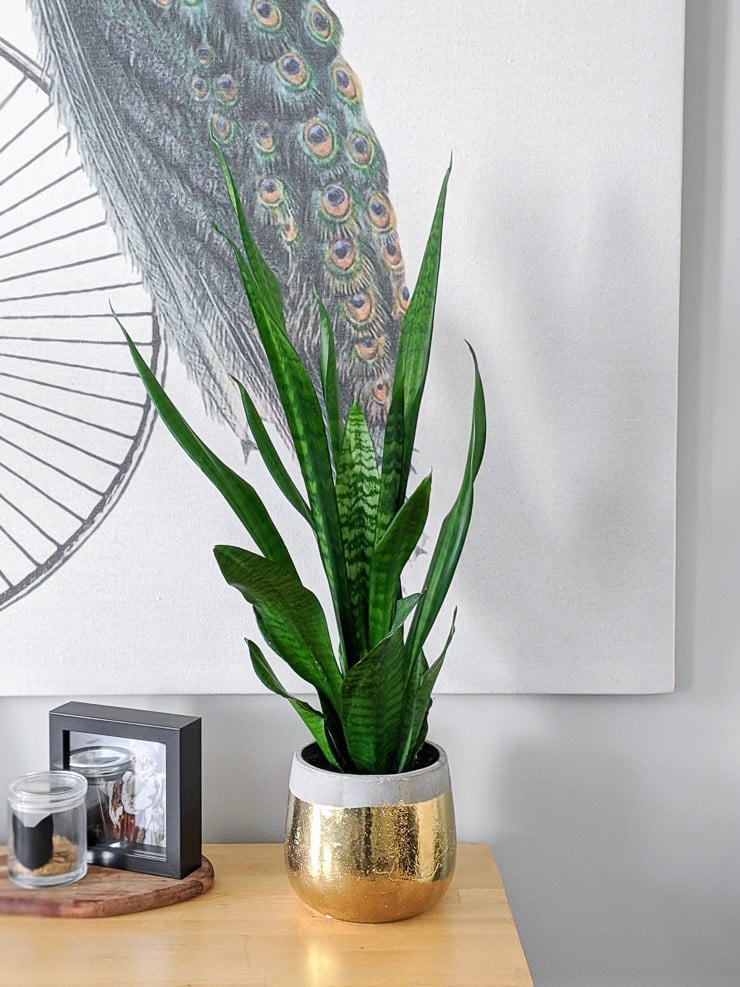
What are the most common snake plant varieties?
There are loads of different snake plant varieties, but there are a few that you’ll commonly see. Here are some I want to highlight.
- Trifasciata: What you’re most likely to find; it has dark green leaves with a lighter green or even gray-whiteish variegation; can get pretty large.
- Trifasciata robusta: Has pretty much the same markings as the regular trifasciata, but its leaves are wider and chunkier.
- Trifasciata laurentii: Another common variety; looks a lot like the regular trifasciata, but it has yellow edges; also grows tall and thin.
- Trifasciata moonshine: Has a gorgeous mint green color with very little variegation; the better the light on the plant, the lighter the color gets. I have a Moonshine Snake Plant Care guide as well.
- Trifasciata cylindrica: The cylindrical snake plant looks a lot like other snake plants in terms of their coloring and variegation, but the leaves are shaped like cylinders. Check out my Sansevieria Cylindrica Care guide for more.
- Masoniana: A non-trifasciata type also called a “whale fin snake plant.” The leaves are thicker and wider. They are often grown as striking solo leaves in a pot. You can check out my Whale Fin Sansevieria Care & Propagation guide as well.
To learn more about different types of snake plants, see my article about the 18 Sansevieria Varieties I’ve Owned including ID pics!

Do snake plants needs direct sunlight?
So let’s get into what you need to know to take care of a snake plant. I’ll focus on indoor care but will also touch on some outdoor care (I take some snake plants outside for the spring and summer!).
First let’s talk about how much light snake plants need. In general, snake plants will thrive in bright, indirect light. I rarely advise direct sun for houseplants, but snake plants are actually able to withstand direct sunlight. Make sure to acclimate slowly to avoid leaf scorching.
Snake plants can also do well in medium and even low light environments. Keep in mind that your care routine will likely change if you have a snake plant in lower light levels. It will likely need less water and will also probably grow much slower.

Where should I place a snake plant in my house?
I have had a snake plant in almost every room in my house because they tolerate and can even thrive in a variety of different lighting environments. For optimal growth, I recommend putting your snake plant near a sunny window. However, if your sunny windows are prime real estate for other plants that need the light more, moving it away from the window is fine.
Bedrooms, bathrooms, living rooms, offices, and even basements are all great choices for snake plants. A large snake plant can also make a great statement piece in the corner of a room like you see pictured below.
You’ll also see it outside in areas that get a lot of sun all year round, like Florida. If you do choose to move your snake plants outside for the spring and summer, I recommend slowly acclimating them to full sun. Going from lower light levels indoors to outdoor, full, direct sun can be a shocker for the plant.

Can a snake plant live in a room with no windows?
Yes, a snake plant can definitely live in a room with no windows. You often see snake plants in medical offices, shops, and malls with less-than-ideal light for that reason.
You’ll want to give them some light, however. If it’s in an office, that can mean the overhead lights that stay on all day. I have had great luck with snake plants in a cubical environment. You can also consider adding a grow light—or simply keeping a nearby light source on for a few hours.
Know that your plant will grow much slower, though. I also recommend keeping an eye on it for signs of stress. If the environment gets little to no light—artificial or otherwise—the plant will eventually die.

How often should I water a snake plant?
Many plants are picky about a handful of things, but the only thing snake plants are truly picky about is water. They are exceptionally drought tolerant plants.
I generally water mine once every 10-14 days in the spring and summer—even less in the fall and winter. However, keep in mind that care conditions in your environment might necessitate more or less frequent watering.
I recommend waiting until the soil has dried out completely before watering the plant again. This may seem like neglect, but the rhizomes and leaves are thick and able to store water to get through periods of drought. So, snake plants do quite well with a bit of neglect.
If you do not wait until the soil has dried out enough, you run the risk of overwatering. Overwatering can quickly lead to root rot, which is one of only a few ways a newbie can kill a snake plant 🙂 If you’re unsure about whether or not the plant needs water and it looks otherwise healthy, give it a bit more time.
I recommend deeply watering your plant when you do water it. Deep watering means to thoroughly soak the plant’s soil until water is running out of the pot’s drainage holes. This deep soak helps to mimic the water snake plants get in their native environment—a period of drought followed by a deep, soaking rain.

How do I know if my snake plant needs water?
There is a big difference in weight between wet soil and dry soil. Once you’ve had your plant for a while and get to know its care routine, you’ll also begin to tell if it needs water simply by picking up the pot.
I like to keep a lot of my plants in plastic nursery pots these days, so when I water them, I just pick the plastic pot up out of the decorative ceramic pot. I can tell when the soil is completely dry by the weight.
But I mark my calendar when I water my plants, so I know about when to start checking to see if my plants have dried out. Checking the soil is always your best bet, because relying on the plant to show outward signs of stress can mean you push your plant too far.
Outward signs that your snake plant needs water are generally thinning, wrinkling leaves and leaves that may lose their rigid, upright structure and begin to flop over. Floppiness can be a sign of overwatering, too—but not if the soil has stayed consistently dry.
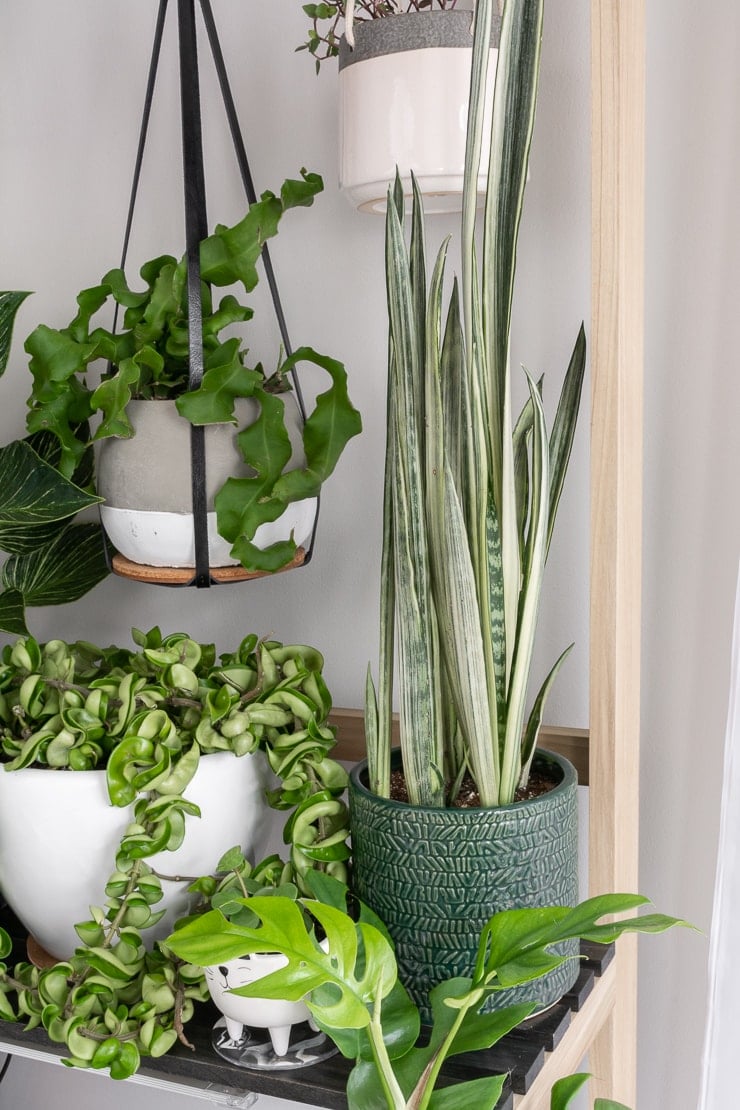
How long can snake plant go without water?
It depends. But I can speak from personal experience that snake plants can withstand great (some would say even embarrassing) levels of neglect. When my daughter was born and I was busy trying to keep a human baby alive, I seriously neglected many of my plants.
The snake plants and some of the other succulents I had were some of the only plants that showed little to no signs of stress. I think I went about a month without even touching the plants or checking their soil—and the snakes were just fine.
For my snake plants I put outside in the spring and summer, I let the weather be my guide. I try to let mother nature do her thing with outdoor plants, but I will water my snakes every few days if it is an extreme dry spell.

What potting soil to use for snake plant?
Snake plants prefer a standard succulent/cactus soil, which comes premixed with things like sand and perlite to enhance drainage and mimic the plant’s more arid natural environment.
A run-of-the-mill mix marked “indoor plants” or “houseplants” will also work just fine. You might want to add a bit of extra perlite to the mix to bump up the drainage factor, but that depends on how heavy the original mix is. You can also see my guide on How to Make Succulent Soil at home for more.

Temperature & humidity needs
Snake plants do well in a variety of temperatures and humidity levels. However, they are best suited for an environment that stays above about 50 degrees Fahrenheit. They don’t tolerate frost well. Cold temperatures can lead to scarring on their leaves, which cannot be reversed.
I can personally attest to snake plants surviving several cold snaps down into the 40s at night, too. We generally experience those in the spring and in the fall after I’ve put some plants outside. As long as the soil doesn’t stay consistently wet, they are fine.
As for humidity, snake plants do well in lower humidity levels. I do not recommend misting snake plants because the increased moisture on the surface of the soil and leaves could lead to fungal or mold growth.
The plants are generally fine with higher ambient humidity levels, though. It gets very humid here in Maryland in the summer, and the plants outdoors do just as well as the plants in my dry house!

When should I repot my snake plant?
Unlike a lot of houseplants, snake plants love to be pot bound, so they don’t necessarily need to be repotted frequently. Have you ever taken a plant out of a pot and seen that the roots have totally taken over the soil, leading to what seems like more roots than soil? That’s a pot bound plant.
Even in ideal care conditions, they are generally slower growing plants. So I don’t repot my snake plants for a few years. Or until they look way too big for the pot they’re in. You can also check the pot’s drainage holes to see if roots are growing out of them—if they are, it’s time!
Repotting a snake plant is just like any other plant. In fact, I think it’s easier because the leaves are so much thicker and sturdier. Simply take the plant out of its existing pot and gently knock off all of the loose dirt. Then just put a layer of soil down, set the plant in, and add fresh well-draining soil all around the plant, covering the roots.
I like to plant my snakes a bit deeper than my other plants so the taller leaves have a lot of support. I have never had any issues doing this. You want to make sure the entire root structure is covered—but then I usually add a few inches of leaves to further stabilize the plant.
Make sure to use a planter with a drainage hole, too. You run the risk of overwatering your plant if you don’t have drainage holes, and I want you to set yourself up for success!

How big do snake plants get?
The size of your snake plant depends on the variety you have. Some varieties can grow to be many feet tall, even as houseplants. My tallest variety has been a trifasciata I had indoors in my living room. From rhizome to leaf tip was probably about four feet. And I had it in a tall planter to make it look even bigger!
The most popular trifasciata varieties you’re likely to find in stores grow to be around 2 feet, with many surpassing 3 feet. The cylindrica (or cylindrical snake plant) is the one that can grow up to 7 feet or so in ideal growing conditions.
Other varieties stay relatively small and compact—like hahnii varieties. They generally tend to grow a bit wider and stay short and squat. Below is an example.
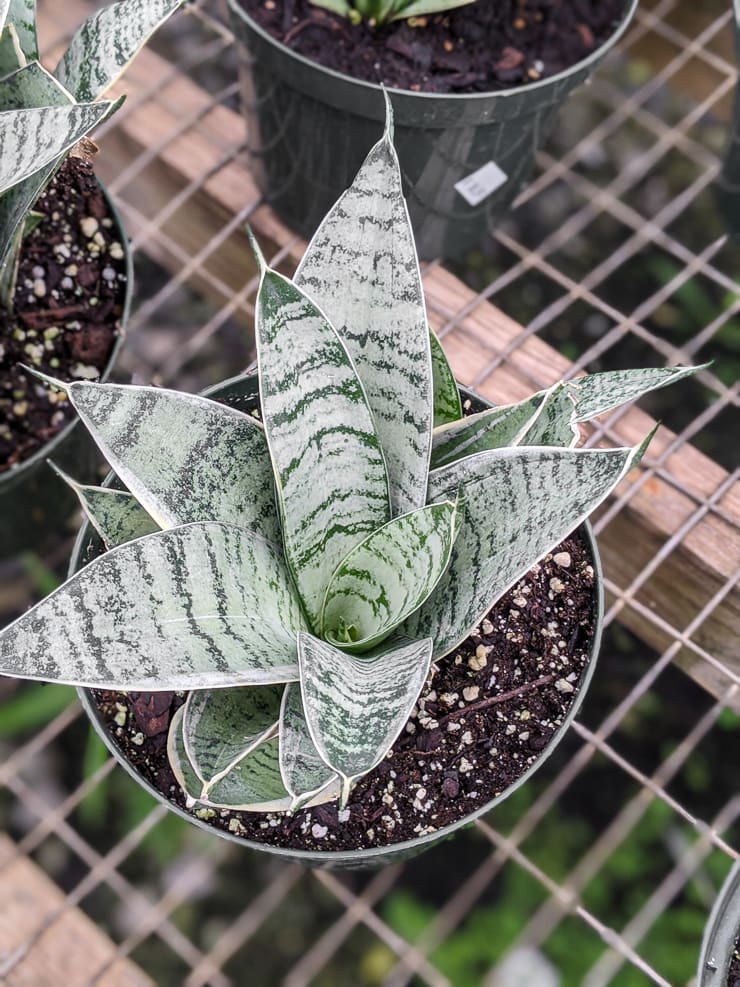
What is the best fertilizer for a snake plant?
Any houseplant fertilizer will likely work fine. Look for something like a 10-10-10 balanced fertilizer. And make sure to follow the frequency and dilution instructions on the packaging. If you don’t you could burn the plant by over fertilizing.
I am generally not a frequent fertilizer. In fact, I haven’t really used fertilizer a ton on my indoor plants. Instead, I used concentrated Liqui-Dirt plant food added to my watering can roughly once a month.
How do I make my snake plant thicker?
The first step to making your snake plant thicker is to provide it with optimal care: plenty of bright light, well-draining soil, appropriate amounts of water, and warm temperatures. You can also encourage healthy new growth by adding a fertilizer or plant food supplement.
However, there is only so much you can do to speed up healthy new growth on a slow-growing plant. So you might consider potting multiple snake plants together in one pot. This is perfectly fine—the plants will look like one plant above the surface. And it will look completely natural considering snake plants reproduce by creating offset babies.
Below is an example of a snake plant where I’d actually planted several different plants together in one pot. These were all the same type of plant and were roughly the same height, so they looked great together! It’s a way to instantly make your plant appear thicker, fuller, and healthier.
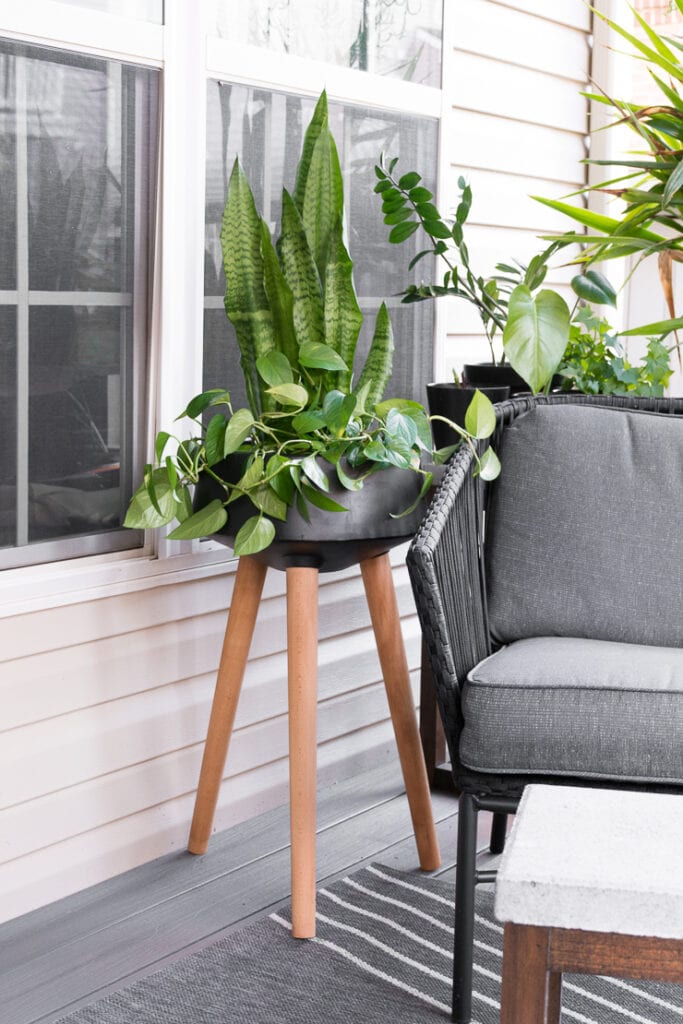
Snake plants & common houseplant pests
Snakes plants are hardy plants but can be vulnerable to the run-of-the-mill houseplant pests: mealybugs, spider mites, and fungus gnats. You can simply wipe off spider mites and treat with an insecticide spray. And treat mealybugs with rubbing alcohol.
Years ago I had a bad infestation of fungus gnats in one of my snake plants that, no matter how much I let the soil dry out or treated the plant, I could NOT get under control. I got rid of them by doing the following, and the plant is now healthier than ever (I have a whole article on how to get rid of fungus gnats you can check out, too):
- Remove the plant from the pot, taking it outside (if it’s warm enough), and laying it on its side.
- Gently remove as much soil as possible from the roots and rhizomes.
- Pour a concentrated solution of dish soap and water over the roots, rhizomes, and bottom quarter of the plant.
- Let it dry for a few hours.
- Cleaning out the pot and letting it dry, then replacing it with fresh, well-draining soil and replanting.

How do you clean snake plant leaves?
Big, thick snake plant leaves are serious dust magnets! I have an article about how I clean houseplant leaves, but here are the basics:
- Dampen a microfiber cleaning cloth with water; squeeze out the excess
- Spray the towel with a very heavily diluted neem oil spray; you only want a little bit.
- Wipe down a few leaves until your cloth needs cleaned. Rinse and repeat!
Another method I like to use is just a simple shower. When I water the plant, I do so in the sink or shower depending on its size. I then rinse off all of the foliage to clear off the dust.

What do you do when a snake plant grows babies?
If your snake plant is growing offsets, pups, or babies—whatever you want to call them—you can pat yourself on the back. That’s a sign of a healthy, happy plant. And if your pot is big enough to hold everything, you don’t need to do anything at all.
You can, however, choose to size your pot up about an inch if you think the baby is taking up too much room in the original pot. Add some fresh well-draining soil if you do so.
Many people often choose to remove snake plant babies from the mother plant and pot them up separately. Whether or not I remove babies depends on the size of the pot, if I want to pass a baby along to someone else, and how the babies contribute to the overall look of the plant. (For example, I like keep my whale fins as single leaves.)

How do you propagate a snake plant?
Now is a good time to segue into propagation. You can propagate a snake plant many ways, and I have a whole guide all about how to propagate them. Here’s a quick overview.
1. Propagating a snake plant by division
Snake plants grow by producing baby plants. The mother snake plant shoots out white rhizomes under the surface of the soil, and you can simply chop these in two and have two snake plants! Let the cut area callus over for a day or so before you replant to help with water intake.
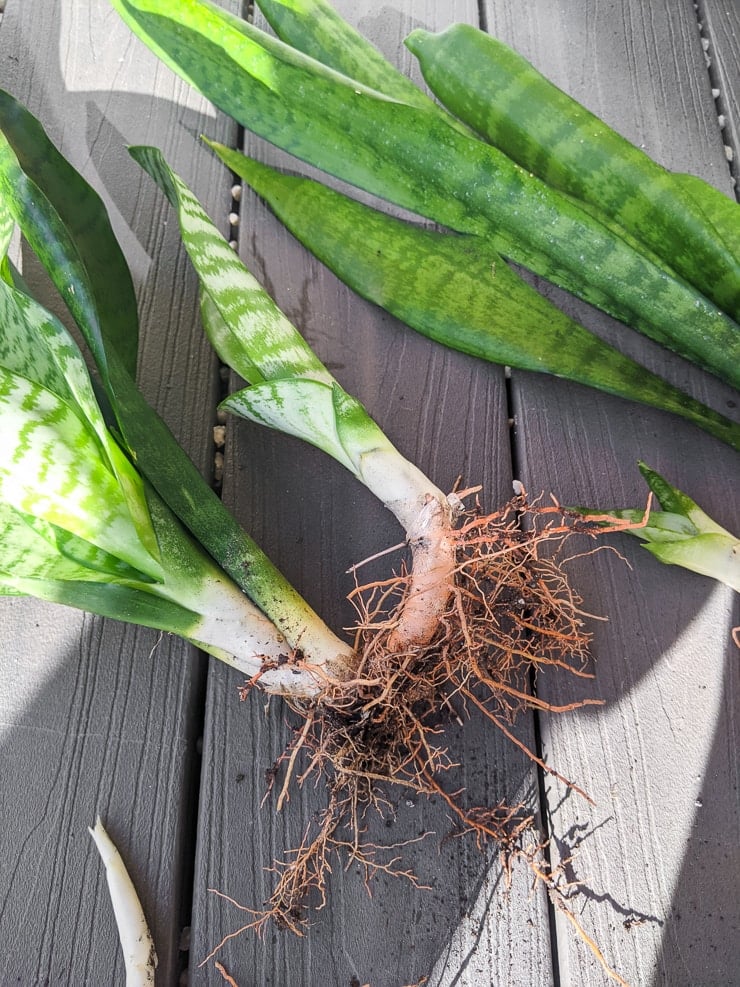

2. Propagating a snake plant by leaf cuttings in soil
You can also cut a single leaf off of a snake plant, cut that into pieces, and pop them into soil. Keep the soil moist and have patience—this takes a while. Eventually the cuttings will begin to root and sprout new plants. Here’s a peek!
Let these grow until the new baby plants sprout from the surface and root. Once you have a new plant, you can chop off the old leaf and plant the propagated snake in a new pot.


3. Propagating snake plant leaf cuttings in water or LECA
You can also cut a single snake plant leaf and root it in water. This can be hit or miss, though, because the cutting can rot. You can lessen the chance of the cutting rotting by letting it callus over for a few days before you put it in a vase. Once you get roots, you can plant the cutting.
If this doesn’t work, you can try to roof your leaf cutting in LECA. I had great success with this method after a near failure rooting a whale fin cutting in water. Check out my article about how to root plants in LECA for instructions on this!


Can a snake plant flower?
Absolutely! The flowers are relatively small and unremarkable, though. While I’ve heard some say that they have a light, sweet-smelling scent, I think they don’t smell like much at all.
Keep in mind that not all varieties bloom, and you might never see your plants bloom given the rarity of it. I have had only one plant bloom, and it was a tiny flower. My mom, on the other hand, recently got a massive flower stalk covered in flowers on her large cylindrical snake plant.
Why is my snake plant falling over?
If your snake plant is falling over, it could be because of a few things. If the plant is otherwise healthy, you may just need to plant it a bit deeper in its pot. And if this doesn’t do the trick, there could be another issue.
If you notice that the leaves are weakening near the soil line, eventually flopping over, they could be dying due to overwatering. Often these leaves turn yellow as well. An occasional yellowing leaf flopping over and dying off it’s a huge deal. But if it’s a systemic issue, you should audit your care routine.

Are snake plants toxic to cats and dogs?
All snake plant varieties are considered toxic to pets (and humans). Just having them around isn’t an issue—it’s ingesting the plant. It contains saponins, which can lead to nausea, vomiting, and diarrhea. I always recommend keeping plants away from nosy pets and children to be safe.
In conclusion…
The snake plant is resilient and versatile, making it an ideal choice for both beginners and experienced plant enthusiasts. Its adaptability to various environments, including windowless rooms, adds to its appeal.
I hope this guide empowers you to cultivate your snake plant collection and fosters an appreciation for these striking (but low-maintenance!) houseplants. Happy planting!
Pin this care guide!



Brittany is a seasoned DIY home and garden expert, running a creative brand since 2014 that inspires others with approachable plant care guides, woodworking tutorials, and decor projects. She is a certified project manager and has completed extensive coursework in the art and science of growing your own plants. Her work has been recognized by major publications, and she routinely collaborates with fellow DIY industry leaders—but her favorite thing to do is inspire you! Learn more about her here.



Leave a comment